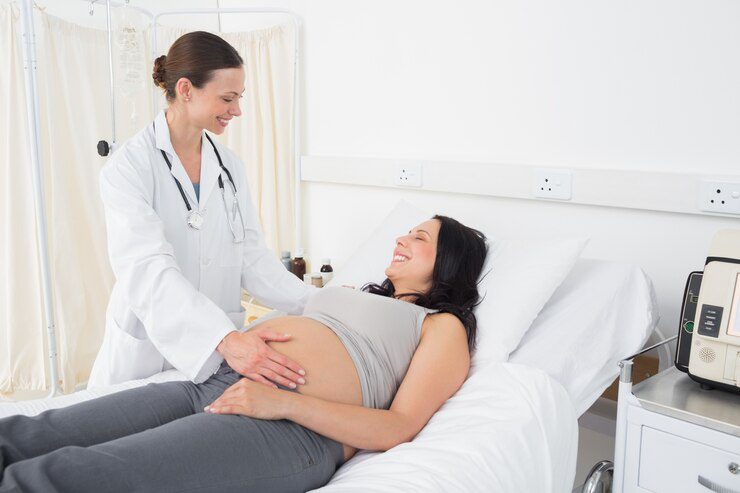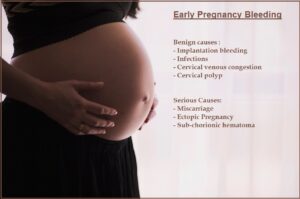The third trimester of pregnancy is the final stage of development, lasting from the first day of the 28 week to 40 weeks, or until birth.
By this time, the baby’s major organ systems have developed. They continue to grow and mature until the baby is born.
The first few weeks of the third trimester is a comfortable time for you with minimal difficult symptoms. But uncomfortable symptoms again start occurring in the last 4 weeks as the baby becomes quite large and the uterus prepares for childbirth.
What are the symptoms of the third Trimester of Pregnancy?
Enlargement of the Uterus
The height of the uterus continues to increase.. By the start of the third trimester, in a woman of average height, it will be approximately 1 inch above the upper edge of the bellybutton. It will be around three to four inches above the bellybutton at the 36th week of pregnancy.
The uterine height will appear to be smaller in taller women, while it may be closer to the breastbone in shorter women.
However, at the end of the 40th week, the height will decrease a little, while the flanks of the abdomen will enlarge and become full. This happens as a result of the baby’s head dropping closer and fixing to the pelvic cavity.
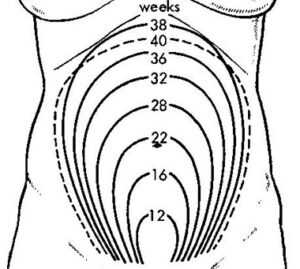
Fetal Movements
The fetal movements become stronger as the baby grows larger and stronger. The The movements may be gentle at first, but can become more frequent and intense as the baby grows. You might feel stretches, punches, and kicks . The movements will apeear to be more intense and stronger when you lie down and rest. You can experience some discomfort from certain motions since they are so powerful.
You may feel the baby’s back on one side of the belly as a smooth, hard oval surface if you lie down on the bed with your knees bent. You will feel a number of little knob-like things that move as you press on them on the opposite side of your abdomen – these are the limbs.
The baby’s movements may also be very less on occasion when the aby rests or sleeps. A normal healthy baby moves at least 10 times in 24 hours . If it is less, it can be an indication that the infant is in some degree of distress.
Fatigue
The fatigue you experienced in the first trimester may continue. The weight of the uterus and the baby both rises significantly. And physical movements can cause tiredness with aches and pains. This is especially true if you gain too much weight during your pregnancy or do not take any multivitamin supplements or eat a healthy diet.
Backache
Backache is very common in the second trimester and may increase as the pregnancy progresses. If you already had a backache before pregnancy, it can get worse after becoming pregnant. You may experience a dragging sensation in the lower abdomen due to stretching of the ligaments and tissues in this area. Poor posture can cause the spine to become more curved, causing you to walk with the characteristic “waddling stride of pregnancy.”
Back pain can be significantly reduced by wearing maternity belts, prenatal cradles, and support belts throughout pregnancy.
Increased Frequency of Passing Urine
The bladder lies directly in front of the enlarging uterus. Pressure by the uterus can reduce the bladder’s ability to store urine and you may find that you need to use the restroom more often. Sometimes, the urgency may be so intense that you may need to rush to the restroom. You may even suffer from urine leakage, especially when you laugh, sneeze, or lift any heavy objects. This is quite normal.
In the later part of the third trimester, the baby’s head wedges into the lower part of the uterus, pressing on the bladder and causing more frequent urination.
Constipation
The large uterus pressing back into the rectum may cause constipation. Additionally, progesterone can slow down the motility of your intestines, which can lead to constipation.
Other causes for constipation in pregnancy, especially in the third trimester could be iron supplements and not taking enough fiber or fluids. Use of soluble fibres, such as Psyllium Husk capsules, will help you feel less constipated overall.
Breathlessness
Breathlessness can be brought on by the uterus pressing against the diaphragm, a strong muscle sheet that lies between the chest wall and the abdomen. Because of this pressure, the capacity of the chest wall to expand can get reduced – this limits the expansion of the lungs. Breathlessness may be worse at night. For comfort, you might need to sleep propped up on pillows. Compared to taller women, shorter women have more shortness of breath due to a smaller abdomen..
Breast Enlargement
The breasts will keep getting larger. A thin, yellowish, sticky fluid known as colostrum may leak from the breasts in the later weeks of pregnancy. This is normal and an indication that the breasts are preparing for breastfeeding. The secondary areola will become more prominent.
Abdominal Fullness
There may be a constant sense of fullness or bloating in the abdomen especially later in the day. You may be unable to eat even when you are hungry. This is because of the pressure of the uterus as well as indigestion and gas build up in the intestines in later pregnancy.
Ankle Edema
Pressure on the veins carrying blood back from your legs might cause edema over the ankles and feet. Fluid leaks out of the veins and gravity causes it to collect around the ankles. Edema is usually worse in the later part of the day and clears up after lying in bed at night.
Varicose Veins
Varicose veins and spider veins may appear on the legs, especially on the lower legs. Some women develop varicose veins around the vulva and vagina. They can also form in other parts of the body, such as the rectum, where they are called hemorrhoids. Varicose veins occur due to a number of factors – the high progesterone levels in pregnancy causing dilating of veins and pooling of blood, pressure by the uterus and increased blood volume.

Chloasma of Pregnancy
Some women may notice that there is pigmentation over their nose and upper cheeks, causing a typoical butterfly like appearance. This is known as Chloasma of pregnancy, Melasma or Mask of pregnancy . Increased pigmentation can also occur on the forehead, cheeks, nose, upper lip, jaw, chin, shoulders, and arms.
Chloasma is caused by hormonal changes during pregnancy that increase the body’s production of melanin. Other causes that may contribute to chloasma include Genetics, Sun exposure, and Skin irritation. It is harmless and usually fades after childbirth.
Lightening Sensation
In the later part of the third trimester, especially in the last 2 weeks, you may notice a lightening sensation of your abdomen. This is due to a decrease in upper abdominal pressure sensations when a fetus moves lower into the pelvis . It can be accompanied by symptoms like pain in the vagina or in the pubic region, increased urgency to pass urine and worsening of constipation.
Braxton Hick’s Contractions
Regular and irregular uterine contractions (also known as the Braxton Hicks Sign or contraction) start to occur during the third trimester. You may mistake them for labour contractions if this is your first pregnancy. But unlike labour contractions, which are unpleasant and steadily grow in intensity and duration, these contractions are not uncomfortable. They go away when you lie down and rest.
Milestones of the Third Trimester:
- The baby’s bones harden, and they gain weight quickly, about half a pound per week.
- Their eyes can open and close, and they can sense changes in light.
- The lungs form fully around 34 weeks but remain solid and without air. In ultrasound,The baby may be noticed practicing breathing movements.
- Their brain and nervous system continue to develop, and they begin to store minerals like iron and calcium.
- The baby’s head may also have some hair, and their limbs begin to look chubby.
Read Questions and Answers on Pregnancy and Gynecology

How to stop my Period…
How can I stop or delay my period? Can I use birth control pills?
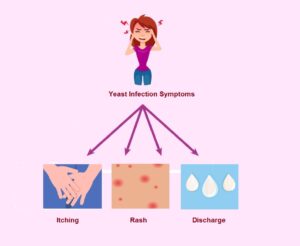
I think I have a yeast infection
I think I have a yeast infection. I had vaginal itching earlier and it is itching again now. What should i do?

I think I have Bacterial Vaginosis
I think I have bacterial vaginosis. I have a vaginal discharge with a fishy odor since the last few days. When should I see a doctor?
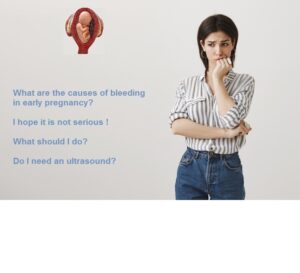
I am in early pregnancy and have dark brown discharge
Early pregnancy bleeding. What is wrong with me? What should I do?

I am in Menopause and Bleeding Heavily
I am 52 years old and in menopause. I have been bleeding heavily for 8 days. What should I do now?

Missed birth control pill. Will I get pregnant?
I missed a birth control pill on the second week. Then I took the next one on time. I also took the placebo pills I day early. Will I get pregnant?
